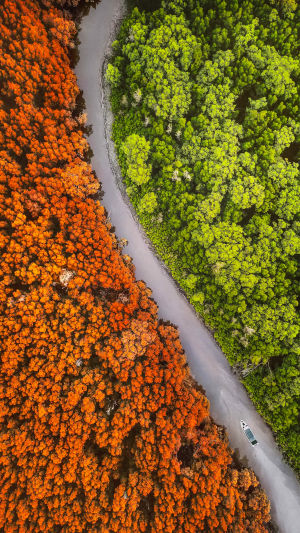The Earth is a masterpiece of colours, with nature painting it in the most spectacular hues. From the underwater rainbow of the Great Barrier Reef, the breathtaking purple landscape of Lavender Fields in Provence to the clearest views of the Grand Prismatic Spring's colours, these landscapes are nature's canvases.
Let's delve deeper into these three destinations, uncovering the best times to visit, their unique characteristics, and how to experience them fully while preserving their natural beauty.
<h3>Great Barrier Reef, Australia</h3>
The Great Barrier Reef is the world's largest coral reef system, famed for its vivid marine life and stunning blues that stretch as far as the eye can see. Snorkeling and diving in these waters offer a glimpse into an underwater kaleidoscope of corals, fish, and other marine species.
Great Barrier Reef, Australia
<b>Activities and Attractions</b>
Snorkeling and Diving: Immerse yourself in the vibrant underwater world.
Glass-Bottom Boat Tours: For those who prefer to stay dry, these tours offer a window into the reef's marine life.
Island Hopping: Visit stunning islands like Whitsunday and Fitzroy Island for beaches and hiking.
<b>Travel Tips</b>
Environmental Care: The reef is a delicate ecosystem. Always follow guidelines to avoid damaging the coral.
Best Viewing Spots: Outer reef sites generally offer more spectacular coral and marine life.
<b>Ticket Prices</b>
Snorkeling Tours: Starting from 150 AUD per person. Includes equipment rental.
Diving Tours: Prices begin at 250 AUD per person, including equipment. Certification may be required for certain dives.
<b>Opening Hours</b>
Tours operate daily, weather permitting, from 8:00 AM to 5:00 PM. Advance booking is recommended due to high demand, especially during peak season (June to August).
<h3>Lavender Fields of Provence, France</h3>
In the summer, Provence becomes a magnet for photographers and nature lovers as the lavender fields bloom into a breathtaking purple landscape. This region is also known for its charming villages, vineyards, and historical sites.
Lavender Fields of Provence, France
<b>Experience the Lavender Season</b>
Lavender Museum Visits: The museum in Coustellet dives deep into the history, cultivation, and uses of lavender, showcasing traditional distillation processes and the plant's significance in Provence.
Cultural Celebrations: Time your visit with the local festivals to experience the cultural heritage of lavender through markets, music, and traditional crafts.
<b>Exploring Provence</b>
Self-Drive Tours: A car journey through the rolling hills and medieval villages offers unparalleled freedom to discover the region's beauty at your own pace, from the fields themselves to the vineyards and historical sites that dot the landscape.
<b>Travel Tips</b>
Timing Your Visit: Early July is ideal for seeing the lavender in full bloom.
Exploring the Region: Rent a car to explore Provence's small villages and scenic routes.
<h3>Grand Prismatic Spring, Yellowstone National Park, USA</h3>
The Grand Prismatic Spring is the third-largest hot spring in the world, with its colors ranging from deep blue in the center to reds and oranges on the edges due to microbial mats. This spring is just one highlight of Yellowstone's extensive geothermal features.
<b>Activities and Attractions</b>
Boardwalks and Trails: A network of boardwalks and trails offer up-close views of the spring and other hydrothermal features.
Geothermal Education: Visitor centers provide insights into the park's volcanic activity and its impact on the ecosystem.
Wildlife Watching: Yellowstone is home to bison, elk, wolves, and bears. Early morning and late afternoon are the best times for sightings.
<b>Travel Tips</b>
Safety: Stay on designated paths to protect the park's delicate ecosystems and yourself.
Best Viewing Time for Grand Prismatic: Visit midday when the light brings out the most vibrant colors in the spring.
<b>Witnessing Geothermal Marvels</b>
Guided Tours: Through educational programs and guided walks, you can learn about the science behind the spring's vivid colors and the park's extensive geothermal features.
Wildlife and Wilderness: Beyond the spring, Yellowstone offers a sanctuary for many of America's iconic wildlife species, presenting opportunities for observation and photography.
<b>Responsible Visitation</b>
Preserving the Park: Adhering to safety guidelines and respecting the natural habitat helps ensure the park remains a source of wonder for future generations.
Seasonal Visits: While Yellowstone welcomes visitors year-round, the spring and summer months offer the clearest views of the Grand Prismatic Spring's colors, with trails and boardwalks providing safe access to this and other geothermal attractions.
Embarking on a journey to these destinations is more than a visual feast; it's an opportunity to connect deeply with nature's artistry, understand the importance of environmental conservation, and witness the diverse expressions of beauty found across our planet. Each visit, imbued with the allure of discovery and learning, promises not just memories but a renewed appreciation for the natural world.





